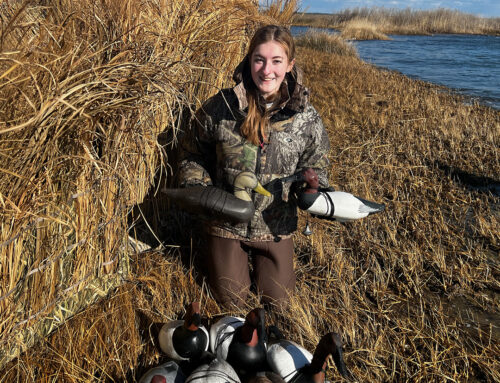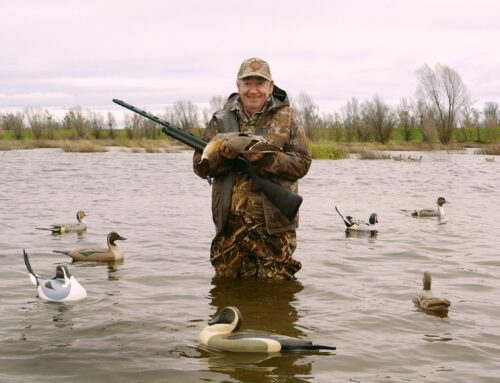In Search of Stellar Canvasback Hunting

Delta Waterfowl founder James Ford Bell forged north in 1923 to pursue the king of ducks
By Paul Wait
A treasure trove of historic black-and-white photos and yellowed documents lay neatly arranged on a mammoth table befitting of the scene unfolding at Heron Lake Farms, a duck club with origins dating to the late 1800s in southwestern Minnesota.
 Frail paper crackled as Michael Mooney, who serves as vice chairman and secretary on the Delta Waterfowl Board of Directors, examined the contents of a seemingly nondescript, well-worn beige file folder. As he turned the pages, the words typed on the century-old parchment unveiled evidence of why James Ford Bell, who was once a member of the very duck club where Mooney now stood, had left his native Minnesota duck hunting haunts behind.
Frail paper crackled as Michael Mooney, who serves as vice chairman and secretary on the Delta Waterfowl Board of Directors, examined the contents of a seemingly nondescript, well-worn beige file folder. As he turned the pages, the words typed on the century-old parchment unveiled evidence of why James Ford Bell, who was once a member of the very duck club where Mooney now stood, had left his native Minnesota duck hunting haunts behind.
The report, “Restoration of Wild Fowl Feeding and Breeding Grounds at Heron Lake, Minnesota” was submitted to Bell by Clyde B. Terrell, specialist on development of attractive places for birds, game and fish. The title page of the report is stamped “on investigations of Heron Lake made Nov. 8 to 14, 1922.”
In the report’s summary, Terrell wrote, “Heron Lake in its day has probably been one of the greatest feeding and breeding grounds for wild ducks in the state of Minnesota. Within a very few recent years, however, the feeding grounds for wildfowl have been sadly depleted, and consequently there are nowhere near the number of ducks that formerly came to Heron Lake, now coming to this place.”
Indeed, Heron Lake had notoriously been a major staging marsh for canvasbacks, even being dubbed as the “Chesapeake Bay of the West.” Canvasbacks, redheads and other ducks flocked to the area each autumn to gorge on abundant beds of wild celery, sago pondweed and other lush vegetation.
Bell, an innovative and successful industrialist in grain milling who later founded General Mills, took great pleasure in waterfowl hunting. Canvasbacks were undoubtedly his favorite among ducks. A well-educated man with a reverence for science, Bell took pride in conservation, and believed that as hunters, we must give back.
So, while the investigation Bell commissioned into the disappearance of canvasback flocks on Heron Lake served his own interests as a duck club member, he most certainly also was concerned about the greater good of the species he so loved to hunt.
“I was engaged by Mr. James Ford Bell to make investigation of this lake to determine the cause of the feeding grounds becoming depleted, and to make suggestions regarding the most feasible ways of bringing back the wild duck food supply, and attracting more ducks to these waters again,” Terrell wrote.
Terrell chemically analyzed lake water, searched for aquatic vegetation, talked to local people and observed the wildlife, birds and fish using the lake. The conclusions of Terrell’s study were certainly disconcerting to Bell.
“One of the things that has been noticed is the absence of canvasbacks and redhead ducks in any considerable numbers on Heron Lake during the last few years,” Terrell wrote. “This is due to the fact that wild celery, which together with the sago pond plant, forms their principal food, has been greatly depleted, and the wild celery almost entirely destroyed. I did not find a single plant of wild celery during my investigation.”
The study revealed that while the water quality in Heron Lake was still sufficient to grow duck food, an invasive species — common carp — had become exceptionally abundant in these waters, in part because fish seining operations had greatly diminished during World War I.
“I am of the opinion that carp are almost entirely to blame for the depletion of the feeding grounds for wild ducks,” Terrell concluded. “To attract more ducks to Heron Lake, I would recommend that war be made on the carp. That they be destroyed and taken out of the lake in every possible way.”
Removing enough carp from Heron Lake to return the waterway to its former glory as a canvasback staging area seemed too monumental a task, even for a resourceful man such as Bell.
The damning evidence of Heron Lake’s demise led Bell to seek his beloved canvasbacks elsewhere.
Bell’s son, Charles, recounted his father’s sentiments in an unpublished story.
“Back around 1921, my father, who had been shooting for many years at Heron Lake, along with a small group of his friends, had secured the rights on the famous Ten Mile Pass at Dalton, Minnesota, since it seemed evident that the Heron Lake shooting was beginning to deteriorate. However, at the same time, father seemed to be convinced that the same thing would happen in the northern part of Minnesota as happened in the southern part, and he felt that if he wanted to secure shooting for himself and his family in the years to come that he would have to go further north into the Canadian area where the majority of waterfowl are raised.”
Bell reportedly first visited the Delta Marsh in 1923, and discovered a wonderful, sprawling 40,000-acre wetland at the south end of Lake Manitoba that canvasbacks favored in huge numbers. Less than two years later, Bell had purchased a hunting club on the marsh.
Concerned that the Delta Marsh not suffer the same demise as Heron Lake, Bell put forth a conservation ethic for all who hunted with him at the new club in Manitoba.
“When I first went to Delta there were no limits except those which were self-imposed,” Bell wrote. “Despite this freedom, we did set limits, both as to the amount and the number of shells to be used in getting that limit. Still it troubled me to think we were destroying without making some effort at replenishment. It occurred to me that it would be possible by artificial means to put back into the air as many or more birds as were killed.”
Bell carried this idea, along with a keen quest for knowledge about ducks — especially the canvasbacks he so revered — forward as he acquired more land at the Delta Marsh.
Ultimately, Bell’s migration north from Heron Lake built the foundation for what would become the Delta Waterfowl Research Station, a now iconic place that became the epicenter of waterfowl and wetlands research in North America.
Paul Wait is editor of Delta Waterfowl magazine.






Paul Wait, Editor
Dear Paul,
I am a retired U.S. Fish and Wildlife Service manager with several indirect connections to both Delta Marsh and Heron Lake. Those connections were greatly facilitated by the discovery of decoy collecting about two-thirds through my 33 plus career when I met my counterpart waterfowl biologist, George Hochbaum. George’s Dad, Albert, became the first scientist of the Delta Waterfowl Research Station as I’m sure you are aware.
Our love of waterfowl and interest in decoys led to a wonderful friendship, leading to my having important two-country’s memorabilia that I believe is noteworthy in the interest of others with similar love and pursuits. George was the source of a Joseph Marr immature canvasback drake decoy in my collection that came through the hands of his uncle, Peter Ward (brother of his mother). Inscribed on the bottom: “79 Herron Lake – Was the pattern from which sprang the local decoys”. I have other items via the friendship with its many visits between Minnesota and Manitoba such as his Dad’s sketches, books, notes from George.
I am at a point in my life of paring things down, not to overwhelm my wife Alynn and family later on.
I have much to forward to you as background by attachments of history and records if you wish to know more,
Howard Lipke 970-219-8509